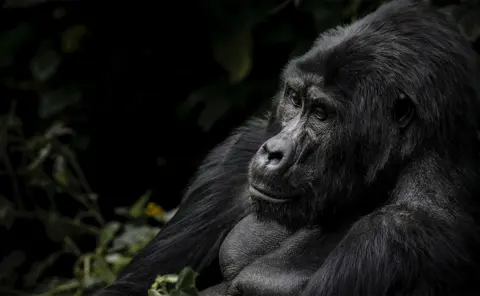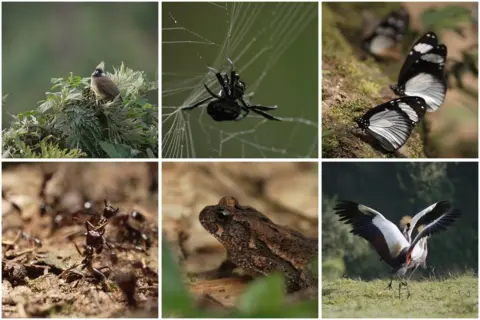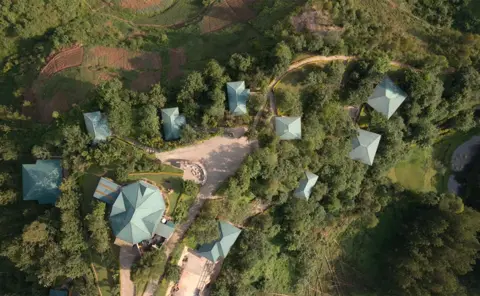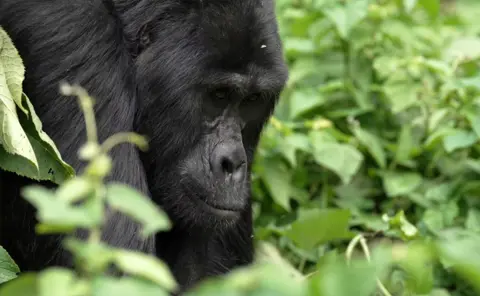Mountain gorillas: The ripple effect of conservation
 BBC
BBCBBC climate editor Justin Rowlatt visits Bwindi Impenetrable Forest, Uganda, to find out what mountain gorilla conservation can tell us about protecting other species.

I could tell she knew I was there. But the burly matriarch of the Nshongi mountain gorilla family was ignoring me as she plucked branches from a bush and lazily munched on the leaves, like a teenager working her way through a packet of crisps.
Then suddenly a baby gorilla tumbled through the undergrowth and past us both. She looked across and our eyes met. Instinctively I lowered my gaze. She wasn't hostile, she just wanted to make sure I knew my place. What was surprising was that I understood exactly what her glance meant. And, even more astonishing, I knew she understood me too.
It is that visceral sense of connection between species which makes visiting mountain gorillas in the wild such a profound experience. Spend just a few minutes in the company of a family of gorillas and the concept of "us and them" dissolves. You meet as equals.
Yet until fairly recently, the world's mountain gorillas appeared to be on an inexorable path to extinction. Sir David Attenborough recently described how his famous encounter with a mountain gorilla family in 1979 had been "tinged with sadness". It was one of the most memorable experiences of his life, he said, but he worried he might be meeting "the last of their kind".
Sir David understands that extinction is part of the evolutionary process - some species die away as others evolve. The problem is species are currently becoming extinct far more rapidly than is usual in evolutionary history. Scientists estimate species extinction is happening at least 100 times more than the normal "background rate". Many believe we are in the middle of a global cull of species comparable in scale to the five previous events in the geological record during which a large proportion of life on earth went extinct.
This matters because biodiversity underpins so much of the functioning of the natural world - from the food we eat to the air we breathe and the water we drink. It also helps protect us from pollution, floods and climate breakdown.
But UN negotiations to stem the tide of extinction in Geneva earlier this year ended in deadlock. This week delegates meet in Nairobi to try to reboot the talks. The aim is to agree 21 targets, including protecting at least 30% of the world's land and seas by 2030.
The hope is to provide a framework for a landmark international agreement under the UN Convention on Biological Diversity that will be signed by governments in Kunming in October. The ultimate goal could hardly be more lofty - for humanity to "live in harmony with nature" by 2050.
 BBC
BBCWe talk a lot about the climate crisis, but much less about the biodiversity crisis. Justin Rowlatt asks what the success of mountain gorilla conservation tells us about protecting other species.
 BBC
BBCSo, does the fate of the mountain gorilla hold lessons for how we can conserve threatened species?
When Sir David visited the family of gorillas there were around 600 mountain gorillas left. The species was listed as "critically endangered". Mountain gorillas cannot survive in captivity so protection in the wild was their only hope.
They live in two groups. One in the Virunga Forest, which straddles the borders between Uganda, Rwanda and the Democratic Republic of the Congo, the other in the Bwindi Impenetrable Forest in Uganda.
 BBC
BBCThey faced the same challenges as many threatened species do today - the habitat they live in was rapidly being cleared by farmers, conservation efforts were being hampered by conflict, and they were sometimes killed by poachers.
But 40 years later, the population is now more than 1,000-strong and growing. The species is now listed as just "endangered" - a significant improvement. In fact, there has been something of a baby boom in the past couple of years. Five mountain gorilla infants were born in Bwindi in late 2020 - an unprecedented number. Just three were born in the whole of 2019.
The secret of this success? Dr Gladys Kalema Zikusoka was the Uganda Wildlife Authority's first vet in 1995, then she set up the charity Conservation Through Public Health. Perhaps surprisingly, she says, carefully managed tourism has been crucial.
"Tourism really does help wild animals if it is done right." But only, she clarifies, if the income from tourism really does flow into the local community.
A gorilla encounter figures high on many bucket lists, and tourist lodges and rest houses, craft stalls and trekking centres, now encircle the Bwindi Impenetrable Forest national park.
 BBC
BBC"When I first started out there were only about five lodges, now there are as many as 70," says Dr Gladys. "The lodges have created jobs, the NGOs have created jobs." Gorilla tourism has boosted the entire regional economy, she says, and now the revenues it generates covers much of the cost of running Uganda's wildlife protection service.
Bwindi's chief warden, Nelson Guma, agrees the income from tourism has been crucial because it underpins the support of the local community. "These communities live next to the park. And so we feel that they should be a part of the conservation, and they should get benefits from conservation."
Visiting a gorilla family is not cheap. You pay $600 per person, Uganda's gorillas receive up to 40,000 visits a year. Local communities get a 20% cut of the revenue from the park.
And mountain gorilla conservation has another huge benefit. To protect the gorillas you need to protect the entire forest ecosystem. The Bwindi Impenetrable Forest is one of the most biodiverse places on earth, so thousands - possibly tens of thousands - of other species are conserved as well.
 BBC
BBCWhat's more, the cash the gorillas help earn has been used to neutralise other threats. Mountain gorillas used occasionally to be caught in the traps poachers set to catch deer, wild pigs and other animals. They would either sell their catch as bush meat or use it to help feed their families.
But once the gorillas became a lucrative tourist attraction, the authorities could afford to make poachers an offer that was hard to refuse - get caught hunting in the park and you'll go to jail, they were told. Stay out and we'll find work for you either in the park or on land provided by charities.
"Now we are the ambassadors of the park," says Vincent Nshmarairw proudly. He's a former poacher who works for an agricultural project funded by the UK-based Gorilla Organisation charity.
Mr Nshmarairw hopes gorillas will be the key to his family's future prosperity. "My children are all at school," he tells me. "And with time maybe they can get jobs from the park."
Tourism is not without problems. Tourists can disturb animals and disrupt their natural behaviour, it generates pollution and waste, and can undermine local cultures. But most of the world's major conservation organisations, including the International Union for the Conservation of Nature (IUCN), Conservation International and the World Wildlife Fund, now support carefully managed ecotourism as a useful conservation tool.
 BBC
BBCTourism is also rarely a complete solution. Despite their economic heft, the mountain gorilla population remains vulnerable. The national parks that the two mountain gorilla populations live in are large, but they represent a tiny fraction of the vast jungle that used to cover the region and, as the gorilla population grows, space is becoming an issue.
"We're definitely seeing that gorilla families are more crowded," says Tara Stoinski who runs the Dian Fossey Gorilla Fund.
Gorillas are "bumping into each other more", warns Ms Stoinski. These encounters are associated with aggression and fights, sometimes with tragic consequences: "We're seeing higher rates of infanticide. Infants can oftentimes be killed when these families come together."
Research by the Gorilla Fund suggests that, in some areas of the Virunga Forest, the growth in the gorilla population is slowing for the first time in decades.
 BBC
BBC"We would love to see this population grow but in order to do so, there's really going to need to be more habitat available to them," says Ms Stoinski.
The answer would be more land set aside for the gorillas - exactly what the UN says needs to happen worldwide. But taking productive land out of action costs money and the developing world says they need financial support to do it. This is one of the main sticking points in negotiations. Developing countries are demanding the developed world pay them $100bn a year to support conservation.
The success of mountain gorilla conservation shows we can save species from the brink of extinction, says the UN's head of biodiversity, Elizabeth Mrema. She is confident the delegates in Nairobi will be able to find compromises when they meet this week.
The question for the world is how much energy and resources we are willing to put into the effort to protect biodiversity. Ms Mrema issues a stark warning: "We've been told by scientists we only have this century to solve the biodiversity crisis. There is no planet B," she says.
All photos subject to copyright
